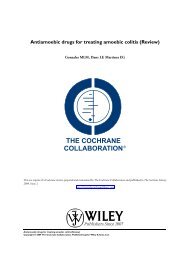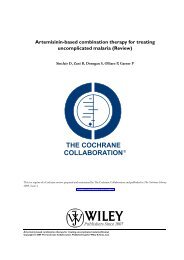Ivermectin for onchocercal eye disease (river blindness) (Review)
Ivermectin for onchocercal eye disease (river blindness) (Review)
Ivermectin for onchocercal eye disease (river blindness) (Review)
You also want an ePaper? Increase the reach of your titles
YUMPU automatically turns print PDFs into web optimized ePapers that Google loves.
concomitant Loa loa infection (another kind of filarial worm infestation),<br />
with very high microfilaraemia. Gardon 1997 reported<br />
two cases of probable Loa encephalopathy after mass treatment<br />
of about 17,877 persons with ivermectin in the Lekie area of<br />
Cameroon, where onchocerciasis and loiasis are both endemic.<br />
Consequently it has been proposed that, be<strong>for</strong>e launching mass<br />
ivermectin distribution programs, communities in which the intensity<br />
of concomitant Loa loa microfilaraemia are highly in need<br />
of being identified and monitoring strategies instituted be<strong>for</strong>e<br />
treatment begins (Boussinesq 1998).<br />
Apart from its use in controlling onchocerciasis, it has been reported<br />
that ivermectin has a secondary effect of reducing intestinal<br />
helminths in humans. Whitworth 1991 showed that ivermectin<br />
had a significant effect on Ascaris (round worm) infection, reducing<br />
prevalence and intensity <strong>for</strong> at least three months. In a qualitative<br />
study in north-east Nigeria on community-perceived benefits<br />
of ivermectin treatment, worm expulsion was the most frequently<br />
stated benefit (Akogun 2000). Other perceived benefits were an<br />
increase in vitality, sexual drive and per<strong>for</strong>mance.<br />
How the intervention might work<br />
Although its exact pharmacological action is not well known, it<br />
is believed to exert its anti-parasitic action on microfilariae either<br />
by acting directly as a Gaba-amino-butyric-acid (GABA) agonist<br />
or by causing an increase in tonic GABA release. It may there<strong>for</strong>e<br />
interfere with neural transmission causing paralysis of parasites (<br />
Aziz 1982). Apart from its microfilaricidal effects, ivermectin has<br />
also been observed to inhibit the release of microfilariae from the<br />
adult worm uterus. The end result of these actions is a reduction in<br />
microfilarial loads in the body and <strong>eye</strong>s, prevention of progression<br />
of <strong>onchocercal</strong> lesions in the <strong>eye</strong> and skin and possibly prevention<br />
of <strong>blindness</strong> in the long term.<br />
There is some debate regarding the potential role of annual mass<br />
treatment with ivermectin in reducing transmission in endemic<br />
communities (Abiose 2000; Richards 2000). It has been shown<br />
that distribution of ivermectin to 60% of the population results in<br />
a 70% to 75% post-treatment reduction in infected flies (Remme<br />
1990). Similarly, mass treatment with ivermectin has been shown<br />
to be associated with a 94% reduction in the number of flies with<br />
developing infective larvae (Trpis 1990). Repeated annual treatment<br />
with ivermectin in Liberia was shown to reduce the incidence<br />
of new infections in untreated children by about 40% in<br />
the second year (Taylor 1990). While these studies indicate a possible<br />
effect of ivermectin in interrupting transmission in treated<br />
communities, the consensus seems to be that this effect is insufficient<br />
to make mass chemotherapy with ivermectin useful as the<br />
sole control measure <strong>for</strong> onchocerciasis in West Africa (Whitworth<br />
1992). Furthermore, results of computer modelling indicate that<br />
in many areas ivermectin treatment alone will not be effective in<br />
eliminating transmission and that only vector control will achieve<br />
this goal (Remme 1990).<br />
<strong>Ivermectin</strong> <strong>for</strong> <strong>onchocercal</strong> <strong>eye</strong> <strong>disease</strong> (<strong>river</strong> <strong>blindness</strong>) (<strong>Review</strong>)<br />
Copyright © 2009 The Cochrane Collaboration. Published by John Wiley & Sons, Ltd.<br />
Why it is important to do this review<br />
The control of onchocerciasis has been based at various times<br />
on large-scale nodulectomy, vector control or large-scale chemotherapy.<br />
The chemotherapeutic agents used prior to 1987 were<br />
suramin and diethylcarbamazine. While suramin was a good<br />
macrofilaricide (efficacious in killing the adult worms), it requires<br />
intravenous injection and was found to be toxic to the kidneys.<br />
Diethylcarbamazine, a microfilaricide (efficacious in killing the<br />
baby worms), was associated with the development of the Mazzotti<br />
reaction, in which massive destruction and death of the baby<br />
worms stimulated a severe inflammatory response. This was shown<br />
to precipitate and accelerate the progression of optic nerve <strong>disease</strong><br />
in individuals with a heavy <strong>onchocercal</strong> infection (Bird 1980).<br />
The World Health Organization (WHO) has defined a new global<br />
strategy <strong>for</strong> controlling onchocerciasis that is based on yearly administration<br />
of single doses of ivermectin to affected populations<br />
(WHO 2000). <strong>Ivermectin</strong> is currently employed by the African<br />
Programme <strong>for</strong> Onchocerciasis Control (APOC) and the Onchocerciasis<br />
Elimination Programme <strong>for</strong> the Americas (OEPA) <strong>for</strong><br />
mass treatment in hyper and mesoendemic communities. In 1987,<br />
Merck & Co., Inc. pledged to provide, at no cost, all the drugs<br />
necessary <strong>for</strong> as long as needed to overcome onchocerciasis as a<br />
public health problem. Between 1987 and the end of 1996, more<br />
than 65 million doses of ivermectin had been donated <strong>for</strong> distribution<br />
(WHO 2000).<br />
Blindness remains the single most important public health problem<br />
posed by onchocerciasis. Though ivermectin has been shown<br />
to be an excellent microfilaricide, it is unclear how this translates<br />
to real benefits in terms of <strong>blindness</strong> prevention <strong>for</strong> those who<br />
suffer the <strong>disease</strong>. The microfilaricidal activity of ivermectin, no<br />
matter how great, is of only academic interest if a villager at risk of<br />
<strong>blindness</strong> from onchocerciasis cannot be told in clear terms how<br />
taking the drug reduces that risk. So far, evaluation of the effectiveness<br />
of ivermectin in preventing <strong>blindness</strong> has been based on<br />
surrogate measures such as the reduction of skin and ocular microfilarial<br />
loads, as well as possible improvement in anterior segment<br />
lesions (lesions affecting the front of the <strong>eye</strong>) such as punctate<br />
keratitis, sclerosing keratitis or iridocyclitis or some of the posterior<br />
segment lesions (lesions affecting the back of the <strong>eye</strong>) such as<br />
chorioretinitis or optic nerve <strong>disease</strong>. However, there are conflicting<br />
reports concerning the effects of ivermectin on these lesions as<br />
well as uncertainties about its effectiveness in preventing progressive<br />
visual loss especially from lesions affecting the back of the <strong>eye</strong>.<br />
This review, there<strong>for</strong>e, aimed to summarise systematically all the<br />
evidence from randomised controlled trials (RCTs) relating to the<br />
effectiveness of ivermectin in preventing progressive visual loss as<br />
well as its effects on <strong>onchocercal</strong> <strong>eye</strong> lesions in order to provide<br />
current best evidence on which to base decisions <strong>for</strong> practice and<br />
further research.<br />
6








